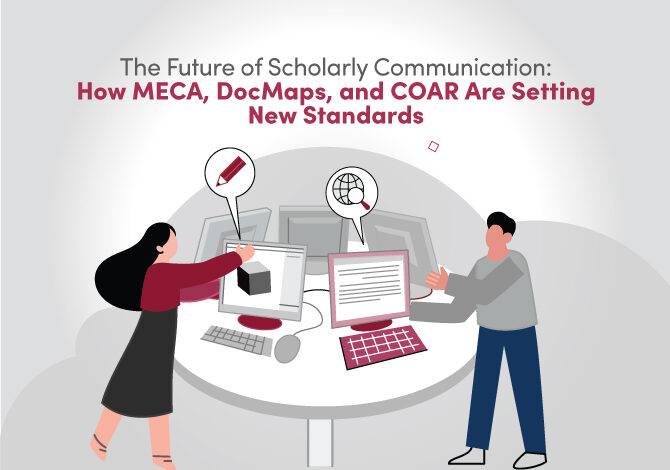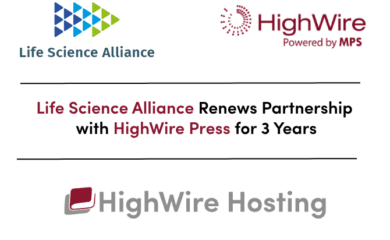The scholarly publishing ecosystem is being driven by the need for more efficient, transparent, and interoperable systems. As stakeholders—ranging from authors and reviewers to publishers and repositories—grapple with these changes, several initiatives are emerging to streamline system to system communications.
This blog examines three such initiatives—MECA (Manuscript Exchange Common Approach), DocMaps, and COAR (Confederation of Open Access Repositories)—each aimed at addressing specific challenges and collectively shaping the future of scholarly communication.
Each of these initiatives addresses a unique set of challenges but shares a common goal: to make scholarly publishing more efficient, transparent, and inclusive. Whether it’s MECA’s focus on streamlining manuscript transfers, DocMaps’ commitment to making the peer review process more transparent, or COAR’s efforts, through their Notify Protocol, to standardize repository practices, these initiatives are redefining the rules of the game.
Let’s dive in.
The DocMaps Initiative: A Solution to the Fragmented Landscape of Preprint Reviews
Emily Esten, the Project Lead for DocMaps at the Knowledge Futures Group points out that the distributed nature of the preprint and peer review ecosystem—comprising publishers, review communities, and aggregators—poses a significant challenge. While this diversity enriches scholarly communication, it also creates a fragmented landscape where crucial review processes are often siloed and opaque. DocMaps aims to bridge these gaps by making the preprint review process visible and standardized across platforms.
Three Pillars of DocMaps
- Extensibility: DocMaps is designed to be flexible enough to represent a wide array of editorial processes. Whether it’s a simple assertion that a review has occurred or a detailed history of editorial comments, DocMaps can capture it all. This extensibility is crucial for accommodating the diverse review practices across different platforms.
- Machine Readability: The framework is built to be computationally interpretable, allowing for automated verification of reviews and seamless interoperability across platforms. This machine readability is not just a technical feature but a facilitator for broader, more efficient dissemination of peer-reviewed content.
- Discoverability: One of the most compelling features of DocMaps is its focus on making review processes easily discoverable. By standardizing metadata and making it queryable, DocMaps ensures that valuable peer review contributions are accessible and usable across various platforms.
A DocMaps Walkthrough
Emily provides a detailed example to illustrate how DocMaps works in practice, capturing the entire lifecycle of a preprint—from initial submission to multiple rounds of review and eventual journal publication. Here’s a step-by-step breakdown:
- Initial Input: The first step in a DocMap is the ‘Initial Input,’ which in this case is a preprint published in June 2022. This initial input is tagged with a DOI (Digital Object Identifier) for easy tracking and reference.
- Assertions and Actions: The DocMap then moves to the ‘Assertions’ and ‘Actions’ stage. An ‘Assertion’ is a status update, like “reviewed,” and an ‘Action’ is an event that has occurred, such as a review taking place. These are also tagged with DOIs or URIs (Uniform Resource Identifiers) for verification and traceability.
- Participants: This section of the DocMap includes information about who participated in the review. While some platforms may include the names of the reviewers, in this example, the reviewers are anonymous. Their role, however, is specified as ‘Peer Reviewer.’
- Multiple Rounds and Author Replies: The DocMap captures the iterative nature of the review process. In this example, there are multiple steps involved, including an ‘Author Reply,’ which is also captured in the DocMap with the participant listed as the ‘Author.’
- Journal Publication: The final stage in this DocMap is the ‘Journal Publication,’ indicating that the preprint was eventually published in a peer-reviewed journal. This is also tagged with a URI and DOI for reference.
- Aggregators and APIs: Emily points out that aggregators like EMBO’s Early Evidence Base play a crucial role in creating DocMaps. These aggregators pull in data from various platforms and compile them into a DocMap, which is then made available via APIs (Application Programming Interfaces).
- Multiple DocMaps: Interestingly, a single preprint can have multiple DocMaps if it is indexed by different aggregators. In the example, both ‘Society’ and ‘Early Evidence Base’ created DocMaps for the same preprint.
- Community Reviews and Dashboards: Finally, platforms like BioArchive can pull this data to display it as part of their ‘Community Reviews’ or dashboards, providing a comprehensive view of the preprint’s review history.
Current Status and Future Directions
As of now, over 10,000 DocMaps exist for preprints, indicating a substantial step towards transparency in peer review. The project has been piloted through partnerships with eLife, EMBO, and Cold Spring Harbor Laboratory. Emily also highlights ongoing efforts to develop a software development kit and comprehensive documentation to make it easier for other organizations to adopt DocMaps. The team is actively working on improving interoperability standards and integrating with existing community standards like MECA and Crossref.
MECA: Automating Manuscript Transfers for a More Efficient Scholarly Ecosystem
Tony Alves, Senior Vice President of Product at HighWire Press, and a Co-Chair of the NISO Standing Committee for MECA, describes it as a “documented methodology describing how to create a package of computer files, and how to transfer the contents of that package in an automated, machine-readable way.” The initiative aims to establish a common, easy-to-implement protocol for these transfers, eliminating the need for multiple pairwise solutions between different systems.
MECA was born out of a need to streamline the convoluted workflows in scholarly publishing. In 2017 John Sack from HighWire Press reached out to Lyndon Holmes, CEO and Founder of Aries Systems, to explore the possibility of a common methodology for transferring manuscripts between various submission systems. The idea was fueled by the industry’s growing frustration with duplicated efforts and inefficiencies, particularly for authors and reviewers.
The project kicked off with representatives from HighWire Press, Aries Systems, Clarivate, eJournal Press, and PLOS. In 2018, a proposal was submitted to NISO (National Information Standards Organization) to formalize the file and data transfer protocols. The working group, comprising representatives from across scholarly publishing, was formed, and the MECA Recommended Practice was officially published on July 6th, 2020.
As Tony notes, MECA is not a software or a database; it’s a technical recommendation. It outlines how a software system should structure files, assemble them, and then transmit those files. The MECA specification fully describes this process, laying out an “easy-to-follow map” for implementation.
How MECA Works
MECA operates through a package of computer files that are transferred in an automated, machine-readable way. The package consists of a mix of XML files and manuscript source files, all wrapped up in a zip file. This zip file serves as the vehicle for transferring manuscripts and associated data between different systems.
The “magic of MECA,” as Tony puts it, lies in its ability to provide an easy-to-follow map for this process. The MECA specification outlines how a software system should structure the files, assemble them, and then transmit those files. It provides a detailed methodology for creating the package, which includes:
- Article XML File: This file contains information about the submission itself, including article metadata. It is compliant with the Journal Article Tag Suite (JATS).
- Review XML File: This is a new Document Type Definition (DTD) created by the MECA team to convey peer review information. It includes questions, answers, comments, ratings, and decision letters.
- Manifest XML File: This serves as an inventory of all the objects in the zipped package.
- Identity XML File: This file is used to identify who is sending and who is receiving the package.
Transfer Protocols
One of the key decisions made by the MECA team was to use Secure File Transfer Protocol (SFTP) for transmitting the package from one system to another. While SFTP is well-established, the team also recognizes that API transmission methods like REST or SWORD could be future improvements.
Unique Identifier
To ensure that a manuscript maintains a consistent identity across multiple transfers, the MECA team decided to use a Universally Unique Identifier (UUID) methodology.
Real-world Implementations
MECA has already seen real-world applications that demonstrate its effectiveness and necessity. The Cell Biology Transfer Network, a coalition of cell biology journals, uses MECA to transfer articles between journals published by different publishers using different submission systems. Preprint servers like BioRxiv and MedRxiv also utilize MECA in their B2J (Bio to Journal) and J2B (Journal to Bio) offerings, saving authors’ time in the submission process.
Flexibility and Future-Proofing
MECA was designed to be flexible and adaptable. The minimal data required to start a submission record ensures that the system can be easily implemented. Moreover, the MECA team is currently exploring two enhancements to future-proof the recommended practice. One MECA subcommittee is looking at how the recently published NISO and STM Peer Review Terminology Standard can be incorporated into the Review.xml file. This standardization of peer review-focused terms will help make the communication of the manuscript evaluation process easier to communicate across systems. A second MECA subcommittee is defining an API that can be used as an alternative to the FTP mechanism for transferring data and files. This is an important enhancement, since many modern systems prefer to communicate via API because it is more lightweight and immediate.
COAR: Pioneering Interoperability and Innovation in Scholarly Publishing
The Confederation of Open Access Repositories (COAR) aims to standardize repository practices and facilitate easier access to research materials, including preprints.
COAR’s primary initiative, the COAR Notify Protocol, aims to serve as the “technical glue” for widespread interoperability across repositories and other services. Launched in 2021 and significantly accelerated by a grant from the Arcadia foundation in 2022, the protocol uses established W3C standards like Linked Data Notifications and Activity Streams 2.0. It facilitates standardized messaging related to requests and responses for peer review and endorsement of resources in repositories.
COAR is also maintaining a list of scenarios and providing resources and technical support to its first-phase implementing partners. These partners are crucial in developing the workflows needed for the Notify Protocol. The most advanced implementation is with Peer Community In & HAL, which have successfully integrated COAR Notify into their existing workflows.
Impact on Scholarly Communication
The adoption of a standard communications protocol like COAR Notify has several benefits:
- Innovation in Scholarly Models: It enables the adoption of innovative scholarly communication models like “read and publish,” overlay journals, and open peer review of preprints.
- Breaking Down Silos: The protocol supports linking and relationships across content types, repositories, and services, thereby reducing duplication and increasing sustainability.
- Open and Inclusive: COAR promotes an open protocol that any interested repository or service can adopt, thereby improving diversity in the ecosystem.
- Transparency and Trust: The protocol enables greater transparency in the review process, which in turn builds trust in scholarship and science.
The Role of Repositories
COAR is particularly focused on expanding the role of repositories within the scholarly publishing ecosystem. It envisions a global approach where peer reviews, endorsements, and overlay journals connect to the diverse content in repositories. This aligns with new developments like “publish, review, and curate” models and research assessment reforms.
Preprints and Repositories
The rise of preprint sharing, especially post-COVID-19, has highlighted the role of repositories in supporting open and early sharing of research manuscripts. COAR, in collaboration with ASAPbio, has been working to develop recommended practices for managing preprints in institutional and generalist repositories.
Closing Thoughts
Initiatives like MECA, DocMaps, and COAR are more than just solving for the industry’s most pressing pain points—manuscript transfer inefficiencies, opaque peer review processes, and fragmented repositories. Together, they serve as a blueprint for a more integrated, transparent, and efficient scholarly publishing paradigm. As they gain widespread adoption, we can anticipate not just improved workflows but a fundamental shift in how scholarly communication is managed and disseminated.



